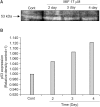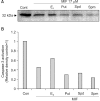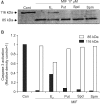Influence of estrogen and polyamines on mifepristone-induced apoptosis in prostate cancer cells
- PMID: 20396571
- PMCID: PMC2855108
- DOI: 10.4143/crt.2004.36.1.85
Influence of estrogen and polyamines on mifepristone-induced apoptosis in prostate cancer cells
Abstract
Purpose: Although androgens are the main steroids controlling the growth of prostate glands, estrogens are also important in the regulation of its growth. Prostate cancer cells, like other cancer cells, maintain high levels of polyamines. In LNCaP cells, apoptosis is induced by mifepristone. During the process of cell death, the regulation of ROS production, caspase-3 activation and poly (ADP-ribose) polymerase cleavage were investigated in the presence of estrogen and polyamines to identify their possible roles.
Materials and methods: The cell growth was assessed using the MTT assay, and the intracellular ROS production by the DCFH-DA assay. The p53 protein expression, activation of caspase-3 and PARP cleavage were checked by Western blotting, with specific antibodies to each.
Results: The growth and viability of the cells were significantly inhibited, in a dose- and time-dependent manners, by mifepristone (MIF) treatment. The production of ROS were dependent on the MIF dosage. The activation of caspase-3 and cleavage of PARPalso increased with the duration of MIF treatment. The expression of p53 protein also increased with increases in the MIF incubation time. E(2) severely inhibited the ROS production, caspase-3 activation and PARP cleavage. However, polyamines only inhibited the ROS production, without influencing the caspase-3 activation or PARP cleavage.
Conclusion: In LNCaP cells, MIF induces apoptosis through ROS production. The expression of p53 protein, caspase-3 activation and PARP cleavage accompanied the process of apoptosis. The apoptotic processes were inhibited by E(2), but polyamines only inhibited the ROS production, implying the multifunctional role of E(2), in addition to its role as a free radical scavenger.
Keywords: Apoptosis; Estrogen; Mifepristone; Polyamine; Prostate cancer cell.
Figures







Similar articles
-
Epibrassinolide-induced apoptosis regardless of p53 expression via activating polyamine catabolic machinery, a common target for androgen sensitive and insensitive prostate cancer cells.Prostate. 2014 Dec;74(16):1622-33. doi: 10.1002/pros.22879. Epub 2014 Sep 11. Prostate. 2014. PMID: 25214240
-
Selenite-induced p53 Ser-15 phosphorylation and caspase-mediated apoptosis in LNCaP human prostate cancer cells.Mol Cancer Ther. 2004 Jul;3(7):877-84. Mol Cancer Ther. 2004. PMID: 15252149
-
Mifepristone induces growth arrest, caspase activation, and apoptosis of estrogen receptor-expressing, antiestrogen-resistant breast cancer cells.Clin Cancer Res. 2004 Aug 1;10(15):5215-25. doi: 10.1158/1078-0432.CCR-03-0637. Clin Cancer Res. 2004. PMID: 15297425
-
Role of reactive oxygen species in p53 activation during cisplatin-induced apoptosis of rat mesangial cells.Eur Rev Med Pharmacol Sci. 2014;18(8):1135-41. Eur Rev Med Pharmacol Sci. 2014. PMID: 24817286
-
Neuronal trauma model: in search of Thanatos.Int J Dev Neurosci. 2004 Nov;22(7):485-96. doi: 10.1016/j.ijdevneu.2004.07.015. Int J Dev Neurosci. 2004. PMID: 15465278 Review.
Cited by
-
Synergistic effect of ionizing radiation and beta-Lapachone against RKO human colon adenocarcinoma cells.Cancer Res Treat. 2005 Jun;37(3):183-90. doi: 10.4143/crt.2005.37.3.183. Epub 2005 Jun 30. Cancer Res Treat. 2005. PMID: 19956501 Free PMC article.
References
-
- El Etreby MF, Liang Y, Lewis RW. Induction of apoptosis by mifepristone and tamoxifen in human LNCaP prostate cancer cells in culture. Prostate. 2000;43:31–42. - PubMed
-
- Eid MA, Lewis RW, Kumar MV. Mifepristone pretreatment overcomes resistance of prostate cancer cells to tumor necrosis factor α-related apoptosis-induced ligand. Mol Cancer Ther. 2002;1:831–840. - PubMed
-
- Kang CM, Suh Y, Jang IS, Park SC. Thymidine-dependent attenuation of the mitochondrial apoptotic pathway in adenosine-induced apoptosis of HL-60 cells. J Cancer Res Clin Oncol. 2001;127(9):570–576. - PubMed
-
- Slee EA, Harte MT, Kluck RM, Wolf BB, Casiano CA, Newmeyer DD, Wang HG, Reed JC, Nicholson DW, Alnemri ES, Green DR, Martin SJ. Ordering the cytochrome c-initiated caspase cascade: hierarchical activation of caspases-2, -3, -6, -7, -8, and -10 in a caspase-9-dependent manner. J Cell Biol. 1999;144:281–292. - PMC - PubMed
-
- Nakamura T, Sakamoto K. Reactive oxygen species up-regulates cyclooxygenase-2, p53, and Bax mRNA expression in bovine luteal cells. Biochem Biophys Res Commun. 2000;284:203–210. - PubMed
LinkOut - more resources
Full Text Sources
Research Materials
Miscellaneous

